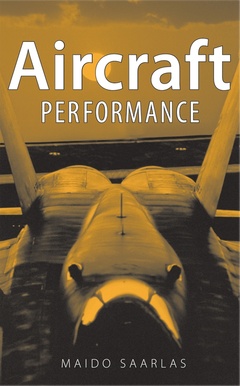Aircraft Performance
Auteur : Saarlas Maido

STRAIGHTFORWARD METHODS TO DESIGN AND OPERATE AIRCRAFT TO MEET PERFORMANCE SPECIFICATIONS
Aircraft Performance sets forth a group of tested and proven methods needed to determine the performance of an aircraft. The central theme of this book is the energy method, which enhances understanding of the standard methods and provides accessibility to advanced topics. As a result, readers gain a thorough understanding of the performance issues involved in operating an aircraft in an efficient and economic manner.
While covering all the standard topics?level and climbing flight, range and endurance, take-off and landing, and maneuvering flight?the book focuses on the energy methods applied to path performance analysis. Throughout the text, numerous examples from both the commercial and military sectors show readers how the concepts and calculations are applied to real-life situations. Problems, ranging from basic to complex, test the readers? understanding and provide an opportunity for essential practice.
To help focus the readers? attention on core issues, this text assumes that aerodynamics and propulsion are known inputs. Special appendices are provided to present some aerodynamic and propulsive equations and data. In general, topics are separated into horizontal and vertical plane approaches. Following an introduction and overview, basic energy concepts are employed to obtain a fundamental performance equation.
This text, with its extensive use of examples and problem sets, is ideal for upper- level undergraduate and graduate students in engineering. It also serves as a reference for design engineers in both military and industrial sectors who want a set of clear and reliable methods to calculate aircraft performance.
1 The General Performance Problem 1
1.1 Introduction 1
1.2 Performance Characteristics 2
1.2.1 Absolute Performance Characteristics 3
1.2.2 Functional Performance Characteristics 4
1.3 The Approach 5
2 Equations of Motion 7
2.1 General Information 7
2.2 The Energy Approach 11
3 The Basics 16
3.1 Fundamental Performance Equation 16
3.2 Stalling Speed 19
3.3 Maximum Velocity and Ceiling 25
3.3.1 General Considerations 25
3.3.2 Drag and Drag Polar 28
3.3.3 Flight Envelope: Vmax, Vmin 34
3.3.4 Power Required and Power Available 47
3.3.5 Turboprop Engines 52
3.4 Gliding Flight 53
3.4.1 Glide Angle and Sinking Speed 53
3.4.2 Glide Range and Endurance 59
4 Climbing Flight 70
4.1 General 70
4.2 Rate of Climb, Climb Angle 71
4.3 Time to Climb 74
4.4 Other Methods 81
4.4.1 Shallow Flight Paths 81
4.4.2 Load Factor n ≠ 1* 88
4.4.3 Partial Power and Excess Power Considerations 94
5 Range and Endurance 101
5.1 Introduction 101
5.2 Approximate, But Most Used, Methods 103
5.2.1 Reciprocating Engine 105
5.2.2 Jet Aircraft 111
5.3 Range Integration Method 117
5.3.1 Basic Methodology 118
5.3.2 An Operational Approach 123
5.4 Other Considerations 126
5.4.1 Flight Speeds 126
5.4.2 Effect of Energy Change on Range 128
5.5 Endurance 129
5.5.1 Reciprocating Engines 130
5.5.2 Turbojets 132
5.5.3 Endurance Integration Method* 133
5.6 Additional Range and Endurance Topics 134
5.6.1 The Effect of Wind 135
5.6.2 Some Range and Endurance Comparisons 142
6 Nonsteady Flight in the Vertical Plane 150
6.1 Take-off and Landing 150
6.2 Take-off Analysis 151
6.2.1 Ground Run 153
6.2.2 Rotation Distance 160
6.2.3 Transition Distance* 162
6.2.4 Take-off Time* 166
6.2.5 Factors Influencing the Take-off 166
6.3 Landing 172
6.3.1 Landing Phases 172
6.3.2 Landing Run 173
6.3.3 The Approach Distance* 175
6.3.4 The Flare Distance* 176
6.4 Accelerating Flight* 178
7 Maneuvering Flight 189
7.1 Introduction 189
7.2 Turns in Vertical Plane: Pull-Ups or Push-Overs 190
7.3 V–n Diagram 192
7.4 Turning Flight in Horizontal Plane 199
7.5 Maximum Sustained Turning Performance 208
7.5.1 Maximum Load Factor 209
7.5.2 Minimum Turn Radius 210
7.5.3 Maximum Turning Rate 213
7.6 The Maneuvering Diagram 220
7.7 Spiral Flight* 224
8 Additional Topics 234
8.1 Constraint Plot 234
8.1.1 Take-off and Landing 236
8.1.2 Constraints Tied to Performance Equation 238
8.2 Energy Methods 245
A Properties of Standard Atmosphere 258
B On the Drag Coefficient 260
C Selected Aircraft Data 265
D Thrust Data for Performance Calculations 267
E Some Useful Conversion Factors 277
Index 280
MAIDO SAARLAS, who is recently retired, has been a professor or chairman of the Aerospace Engineering Department at the United States Naval Academy for the last thirty-eight years. He received his undergraduate and master’s degrees at the University of Illinois and his doctorate at the University of Cincinnati. His industrial experience includes work with Bell Aircraft, North American, Douglas Aircraft, and General Electric companies. He is an author or coauthor of two books: Steam and Gas Turbines for Marine Propulsion and An Introduction to Aerospace Propulsion.
Date de parution : 12-2006
Ouvrage de 296 p.
15.8x23.6 cm



